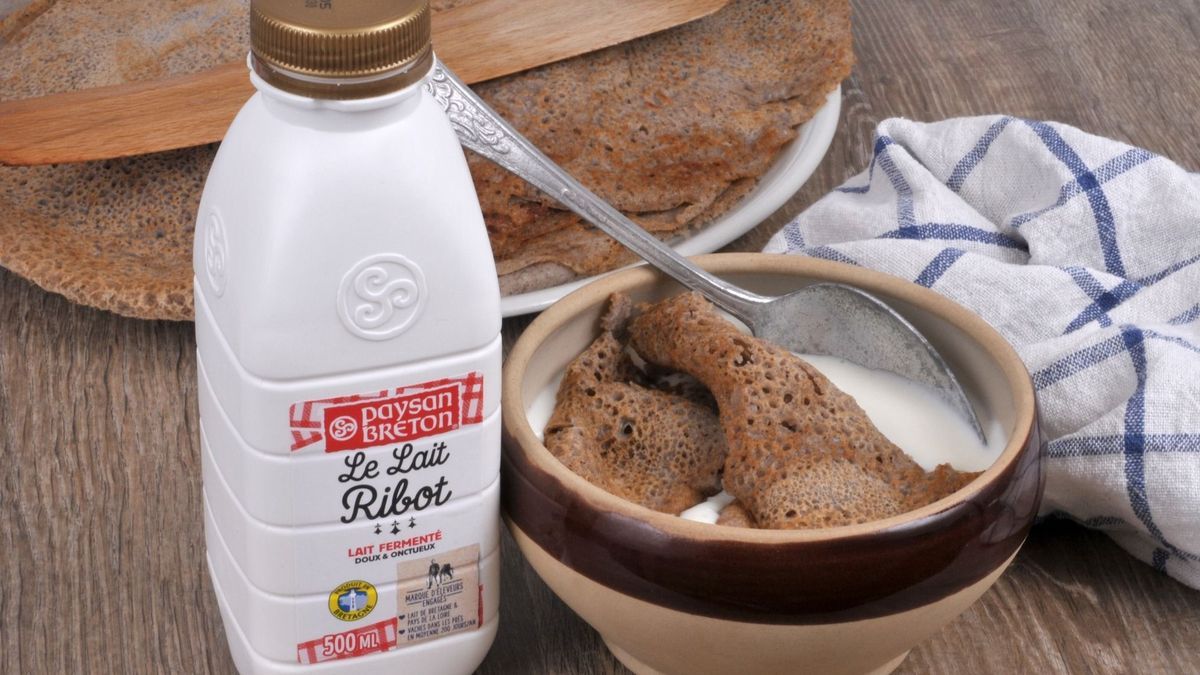
This Breton culinary specialty, which resembles a drinking yogurt, is none other than cow’s milk fermented with the addition of lactic ferments. Rich in proteins and probiotics beneficial for digestive health, it is distinguished by its creaminess and slightly acidic taste. It lends itself to many recipes, from traditional bread to the most gourmet desserts. Raphaël Gruman, dietitian and nutritionist, talks to us about the benefits and nutritional benefits of buttermilk.
What is buttermilk?
Buttermilk is a traditional drink from Brittany made from the fermentation of cow’s milk. Its name comes from the Breton “ribod” which means churn, in reference to the original method of its manufacture. Churning is a manufacturing process used to produce butter from cream. Buttermilk is the residual liquid from churning.
Composition of buttermilk
Buttermilk is produced from cow’s milk and lactic ferments. “The milk used can be whole, semi-skimmed or skimmed to obtain a product more or less low in fat.” specifies Raphaël Gruman. The lactic ferments used to make it are very specific and come from the bacterial strains Streptococcus thermophilus and/or Lactococcos lactis.
Benefits: Is fermented buttermilk good for your health?
Fermented buttermilk is a very healthy product that would benefit from being popularized and more widely consumed. “The fermentation it undergoes promotes the development of good bacteria, useful for seeding the intestinal flora” explains the dietician. The importance of a rich and varied intestinal flora no longer needs to be demonstrated, whether for intestinal comfort, for the synthesis of vitamins or for stimulation of the immune system.
Buttermilk is also an excellent source of calcium (120 mg per 100 ml) – essential for the growth and strength of bones – whose intestinal absorption is favored by the presence of lactic acids.
“On the vitamin side, we find water-soluble vitamins B2 and B12, as well as vitamines A and D when not skimmed” adds Raphaël Gruman. Finally, some studies associate the consumption of fermented products (yogurt, buttermilk, kefir) with a reduction in the risks of type 2 diabetes, metabolic syndrome and heart disease.
Buttermilk or kefir: what’s the difference?
Buttermilk and kefir are both fermented dairy products, making them two very similar foods nutritionally. “These two fermented milks differ mainly by their fermentation method and the nature of the lactic ferments used.” specifies the nutritionist.
Buttermilk is naturally fermented with only one or two strains of lactic ferments, which gives it a very mild flavor. It comes from a process of churning cow’s milk, hence its liquid nature and slightly acidic taste.
Kefir is made from kefir grains, which contain 60 strains of good bacteria and yeast which give it a tangy taste and a slight effervescence in the mouth. These two fermented milks nevertheless have a very similar texture, and can be used in the same way, in drinks or in cooking recipes.
Crêpes, pancakes, cake, muffin, panna cotta… what to do with buttermilk or fermented milk?
Buttermilk is widely used in cooking, where it can also be an ingredient of choice in many recipes. It is particularly a very good alternative to milk in the making of crepes or pancakes, to which it gives a tangy touch and an airy texture. In fact, combined with two pinches of baking soda, the acidity of buttermilk gives the dough a well-inflated, so-called “fluffy” appearance.
In cakes, cakes and other muffins, buttermilk ensures incomparable softness and a slightly tangy flavor which perfectly balances the sweetness of desserts.
Finally, ribbot milk can replace cream for a light but equally creamy panna cotta. All you have to do is gently heat the buttermilk with sugar, add the gelatin then leave to cool before enjoying.
Is there lactose in buttermilk?
The lactic ferments used to make buttermilk feed on lactose, which they transform into much more digestible lactic acid. “Buttermilk is therefore very interesting for all lactose intolerant people, who have little or no lactase enzyme capable of digesting lactose.” explains Raphaël Gruman. Buttermilk is therefore naturally lactose-free and therefore very digestible for everyone.
